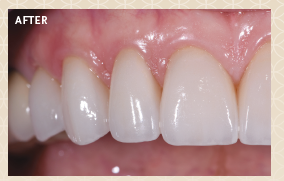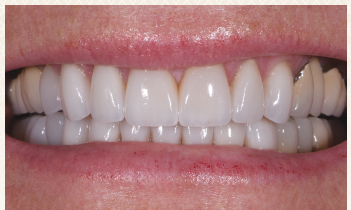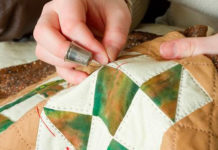
Noninvasive Soft Tissue Advancement in Conjunction with Aesthetic Dentistry.
Part 2: Anterior Restoration
When Abby first presented at our office, the main goal was to treat the symptoms she was having. Her chief complaint was headaches and her bite not feeling “right.” Patients often think they are suffering from temporomandibular joint dysfunction (TMJ), but most of the time their symptoms are caused by muscle issues that relate to how the teeth come together. Typically, the teeth aren’t meeting in a way that supports the muscles.
For such patients, it’s important to eliminate the dysfunction and the pain as soon as possible. Because Abby’s teeth had worn down, her muscles were foreshortened. This was the cause of her headaches and muscle dysfunction—her muscles would spasm. Additionally, her gingiva had receded quite aggressively.
Abby underwent splint therapy to re-establish the proper physiologic rest position for her muscles. Initially, we addressed the proper vertical dimension for her bite. Using that measurement, we created an orthotic that supported her muscles. This alleviated her pain, but she had to wear the orthotic continuously to be effective.
Our next step was to address the underlying issues so that her bite could be restored, giving her the dynamic necessary for her occlusion to support her musculature, preventing her headaches and also hopefully improving her sleep. After the restoration was complete, she would only need an orthotic at night to protect the restorations.
Restoration
It was important to address Abby’s gingival recession first. Once the gingiva had healed sufficiently, we moved forward with completing Abby’s anterior restoration on her uppers and lowers. I used a diagnostic White Wax-Up to create a mock-up of what the restoration would look like and she was pleased with the direction of the treatment.
On prep day, the patient arrived and we went through a series of steps to prep each tooth. We followed a protocol that I teach in the Full Arch Reconstruction course with the Dr. Dick Barnes Group. The protocol makes it possible for same-day large case treatment.
For Abby, we prepped and temporized everything on the same day. She was in the temporaries for four weeks. At that time, we gave her a protective nocturnal orthotic, which she wears nightly to protect her teeth and gingiva.
After the prep day, communication with the lab became critical. The lab needed to know the desired color, shape, and size. We communicated back and forth with the lab, making small alterations or corrections, then the lead technicians fabricated the final restorations.

![]()
The next step was the insert appointment, which involved placing all the restorations, getting approval from the patient before cementation, and then following that checklist of how the restorations have to be placed.
Success
The after pictures show the outstanding results from the Pinhole® Surgical Technique and how the gingiva has matured. The results were absolutely stellar. Grafted sites often have color differentiations, meaning the gingiva looks pink in some areas and has white patches in others. Abby’s gingiva looks uniform and healthy.

![]()
The availability of the Pinhole® Surgical Technique has improved case acceptance for our patients who need gingival grafts. A lot of people understandably dread going through the pain and discomfort of a gingival graft. Decreasing the postoperative pain and the complications with traditional gingival grafting surgery has given us a new way to help improve our patients’ overall dental health. It’s more palatable, no pun intended. It’s a really big improvement. Who wouldn’t want a less painful procedure?
Keep in mind, that even with the advanced technique, it’s not an instant makeover. It takes time and patience from both the doctor and the patient to wait until you have confirmation that the gingiva has accepted that position and will stay in that position.

![]()
I’m really proud of Dr. Zalesky because he worked hard to learn the technique and our patients will benefit from his expertise.
If you asked Abby her favorite part of the whole procedure, she says not having headaches anymore and having a beautiful smile. The success of this procedure is unmatched from anything else we’ve seen in the area of gingival surgery.









